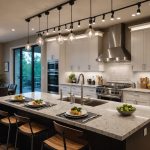Overview of Creative Countertop Edge Designs
When designing a kitchen or bathroom, the importance of countertop edge designs cannot be overstated. These small details contribute significantly to the aesthetic appeal, while also offering practical benefits, such as spill prevention.
Innovative countertop edges provide a finishing touch that can effortlessly enhance the overall style of your space. Beyond their visual appeal, they also serve a practical function by containing spills and preventing liquids from seeping onto the floor. This dual function makes them an ideal choice for both appearance and functionality.
This might interest you : Revolutionize your modern kitchen with the benefits of touchless cabinets
There are various creative countertop edge designs available, each adding its own unique character:
- Ogee Edge: Featuring a classic S-shaped curve, this design adds elegance and grandeur.
- Bullnose Edge: With a rounded profile, it offers a smooth and safe finish.
- Bevelled Edge: Known for its angled surface, this design adds a modern touch.
- Half Bullnose Edge: It features a rounded top with a flat bottom, combining simplicity and style.
By choosing the right edge design, homeowners can amplify their counters’ functionality while underlining the unique features of the room. The choice to incorporate these creative countertop edges ensures both aesthetic appeal and enhanced practicality, blending style with spill prevention effectively.
In parallel : Must-have mold-resistant backsplash materials for your kitchen: elevate aesthetics and hygiene
Types of Countertop Edge Designs
When considering countertop edge styles, understanding the range of profile options and how they align with different design suitability is essential.
Beveled Edges
Beveled edges offer a distinctive, angled finish that enhances the edging’s aesthetics. These edges are celebrated for their sleek appearance, making them perfect for contemporary or traditional settings. Ideal materials for beveled edges include granite and engineered stones, which can accentuate the sharp lines of this design. In environments where elegance is preferred, the slant of beveled edges can play a significant aesthetic role, enhancing light reflection and adding depth to surfaces.
Rounded Edges
Rounded edges are soft and smooth, reducing the risk of spills and injuries. They are especially popular in family homes with children. Durability is critical, so materials like quartz and solid surfaces are ideal due to their resilience. Rounded edges soften the countertop’s look, creating a more inviting ambiance. For homeowners inspired by safety and softness, these edges are a smart choice.
Square Edges
Square edges bring a contemporary look to any room, blending seamlessly into modern kitchens and bathrooms. Their straightforward lines offer a minimalist aesthetic, yet they are consistently effective in containing spills compared to more intricate designs. Frequently chosen for their simplicity and modern appeal, square edges complement sleek cabinetry and urban design themes effectively.
Materials Used for Creative Edges
Choosing the right countertop materials for creative edges is crucial for both aesthetics and functionality. Various materials, such as granite and quartz, offer a mix of edge durability and design versatility, each with distinct advantages.
Granite is a popular choice for its natural beauty and resilience. Its hard surface makes it resistant to scratches and heat, ensuring long-lasting durability. However, granite requires regular sealing to maintain its appearance and prevent staining. In contrast, quartz is an engineered material combining natural stone with resins. Known for its non-porous surface, quartz is highly resistant to stains and bacteria, requiring less maintenance than granite while offering a wide range of colours and patterns.
Wood countertops bring warmth and character to kitchen spaces. They are often chosen for their unique appearance and can be customized through various edge profiles. While wood is less durable compared to stone, periodic oiling and sealing help protect the surface from moisture and wear.
When selecting the perfect material for your countertop edges, consider your kitchen’s overall style and the design versatility of each option. If you prioritize low maintenance, quartz may be ideal; for a natural, classic look, granite could be the best fit. Each material offers different levels of durability and aesthetics, so base your decision on personal preference and practical needs.
Practical Tips for Designing Countertop Edges
When designing countertop edges, achieving the right balance between style and functionality is crucial. One of the primary concerns should be how well the edge design prevents spills. Rounded edges, for instance, can help keep liquids from overflowing onto the floor. This is especially important in busy kitchens where frequent spills occur.
Designing for both small and large spaces requires different approaches. In compact areas, sleek and minimal design tips can help make the kitchen feel less cramped. Simple edges like straight or eased can enhance the clean look while maintaining functionality. Conversely, larger countertops afford more creative freedom, allowing you to experiment with intricate designs like ogee or bevelled edges, which add elegance without compromising on spill prevention.
It’s easy to make mistakes when selecting edge designs that neither complement the style nor serve functionality. For example, while elaborate edges may look appealing, if they don’t serve the practical need of spill containment, they could end up causing more issues than they solve. Hence, it’s essential to carefully consider both aesthetic considerations and practical aspects in the final design decision. Avoiding these common pitfalls ensures a more harmonious and efficient kitchen space.
Visual Inspiration for Countertop Edge Designs
Exploring different countertop edge designs can significantly enhance the aesthetic appeal of any space. Before making a decision, gaining design inspiration from visual examples can provide valuable insights into style possibilities and trends.
Gallery of Unique Edge Designs
A gallery filled with curated images of innovative countertop edges offers a glimpse into current design trends. Each photo not only showcases a unique pattern but also highlights how different materials and shapes contribute to overall aesthetic enhancement. From traditional ogee to sleek waterfall edges, these visual examples serve as a rich source for sparking creativity. Observing such designs in a variety of kitchen and bathroom settings demonstrates the transformative power of countertop edges, making them an important feature in the decision-making process.
Real-Life Applications
Real-life applications further illuminate the practicality and allure of distinct edge styles. Case studies of homeowners who integrated creative edges into their design projects reveal the impact on space aesthetics. Personal testimonials often reflect satisfaction with chosen designs, such as enhanced functionality or added visual flair. Many find that tailoring edge profiles to their home’s style significantly improves the ambiance, aesthetics, and flow of their living spaces, validating the importance of thoughtful edge design selection.
Comparisons of Edge Designs for Aesthetics and Spill Prevention
In the realm of edge design comparisons, the balance between aesthetic functionality and spill prevention is crucial. Various designs boast unique methods of ensuring spill containment while maintaining visual appeal. Some edges are raised slightly, creating a barrier against accidental spills, whereas others incorporate grooves to channel spills inward, away from the tabletop.
Aesthetic functionality plays a pivotal role in choosing the right design. Raised edges, while practical, might not always align with a minimalist aesthetic, whereas smooth, rounded edges are more visually pleasing but may compromise spill prevention. Designers often experiment with materials, integrating glass or metal elements to enhance the aesthetic without sacrificing functionality.
For optimal spill prevention and visual appeal, several factors should be considered. For those prioritising a modern look, rounded designs are recommended. Conversely, if spill prevention is paramount, edged surfaces like those featuring enclosed grooves provide better solutions.
In essence, striking an equilibrium between aesthetic functionality and practical needs ensures both beauty and utility. Always consider your environment and daily habits when selecting a design. Whether for a bustling kitchen or a sleek office, edge design can significantly affect both functionality and style.











